
Timelines are excellent tools for showing spans of time, but many people forget to use the tools for critical thinking and meaningful lessons.

Unfolding of events. Cause and effect. Critical thinking. Timelines can guide students through these important lessons. Here are some ideas. (Image via Storyboard That)
Timelines are great graphic organizers because of their linear, but discrete, nature. Each event is separated on the line itself – and two events can occupy the same time, just on opposite sides of the line. Whether looking at a story or the history of transportation innovation, timelines are really valuable for understanding the unfolding of events, causes and effects, and much more.
Teachers constantly need new ideas, but they have to do what works for their students. Many of these lesson ideas are transferrable to another subject, another grade level, or both. Mold your own.
(Note: The Timeline layout on Storyboard That is a premium feature. With a free account, users are able to make traditional three- or six-celled storyboards. All Storyboard That versions have access to the entire art library of scenes, characters, and items, but specialty layouts and added privacy features are only available with a premium account. All storyboards created with a free account will be made public. The free Education trial includes all features of a premium account for two weeks.)
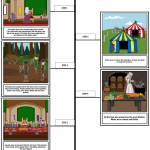
Example of using a timeline to demonstrate sequence: “Steps to prepare for a medieval feast”. Click to see full timeline image. (Image via Storyboard That)
Sequence
Chronological order is an important concept that can be surprisingly tricky, depending on the topic. Putting things in order — or doing things in order — can make a big difference. Making sense of chronological order is important for cause and effect, passage of time, character or plot development, procedures, and more.
Show the events of a story, sequence of steps, order of operations, roleplaying scenario, or whatever else you can think of, in a random order. Have your students rearrange the cells of a timeline on Storyboard That. Some teachers may wish to use dates, times on a clock, sequence words, step numbers, or narrative text to assist their students, and some may wish to rely solely on visuals.
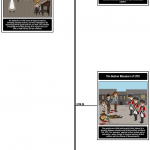
Example of using a timeline to demonstrate events leading up to a significant occurrence: “Acts and Actions, 1764-1773”. Click to see full timeline image. (Image via Storyboard That)
Events Leading up to a Significant Occurrence
Significant occurrences usually do not just happen by chance. There are many significant events in history that have altered human understanding, political systems, and the natural world. Sometimes events happen with little notice or no forewarning, but most have signs or precipitating events. Looking at these causes can show us why something happened, and maybe even help us understand how events might have been avoided. We can use this knowledge for benefits in the present and the future.
The importance of the significant occurrence often overshadows the causes, but it is the causes that show us why something happens.
Create a timeline of events leading up to the important or significant one. Depending on your objective, you may want to include events that happened before, but do not necessarily directly influence the major event. After creating a visual timeline, perform a written assignment or have a discussion including questions such as the following:
The example is the events leading up to the American Revolution, but this can easily be used for events in a novel, an important scientific discovery, or a social issue.
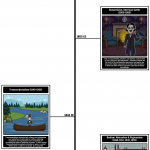
Example of using a timeline to demonstrate evolution or progression: “American Literary Movements”. Click to see full timeline image. (Image via Storyboard That)
Evolution or Progression
Our world is always changing: physically, socially, politically, aesthetically. Over time, many of our styles or habits have evolved because people have made improvements to what was done previously, or modified with the times.
Create a timeline showing the evolution of a product, style, or practice. Notice the reasons behind the changes: trying to solve a problem, making conscious changes for improvements or defiance, changing over time naturally, etc. As styles have changed throughout history, what has that meant for people in general or of different classes/races/religions/locations? As ideas have been honed, what have people been able to do?
Here are just a few ideas to get you thinking of what is applicable to your students:
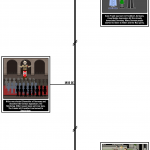
Example of using a timeline to demonstrate historical context: “Anne Frank Timeline”. Click to see full timeline image. (Image via Storyboard That)
Historical Context
Historical setting affects plot, theme, character development and more in a story, so it is wise to put the story in historical context. This can be done before and even during reading.
Make a timeline of the historical period of the story that blends events from real life and events from the story. This could easily be used to compare a nonfiction story with a broader view of the setting.
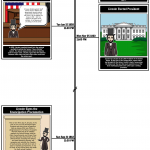
Example of using a timeline to demonstrate the biography of a person’s life: “Biography of a President”. Click to see full timeline image. (Image via Storyboard That)
Biography of a Person’s Life
There are some amazing people who have altered the course of history! Let students get inspired to make change in their own lifetimes by showing what other people have accomplished.
Students may have a hard time connecting with important historical figures on a personal level, so set them next to the greats! Make two timelines: one traditional timeline of another person’s life, and the second a (realistic) future timeline of yourself. Literary characters are also up for grabs! Make comparisons of your own life trajectory with the life of a hero and plan steps for the future.
Timelines are very useful for organizing information in sequence, but it is what you do with the information that makes a difference! Push student thinking beyond dates and order; look for causes and whys and hows.
Storyboard That is a fun and easy online tool to use for timelines, other graphic organizers, presentations, and comics. Make a timeline right now!
For notifications of new Ditch That Textbook content and helpful links:
Interested in having Matt present at your event or school? Contact him by e-mail!
Matt is scheduled to present at the following upcoming events:
[getnoticed-event-table scope=”all” expanding=”false”]
Session expired
Please log in again. The login page will open in a new tab. After logging in you can close it and return to this page.
Hi, I’m Pablo and I’m a student from the University of Murcia. I was looking for some pages about other methods instead of textbook for the subject School Organization and Educational Resources and I found your posts quite interesting. We are right now investigating the bad things of textbooks and your page helped me to learn other methods that could replace textbooks.
I will continue reading your posts. Thank you!!
Great to hear, Pablo. Thanks! (PS: I LOVE your blog title — Frisky Hedgehogs … very cool!)
Here is a page with Social Studies Resources in General- http://techweb.apps.sparcc.org/social-studies.
Here is a link to a collection of Timeline and Chronology Tools- ://docs.google.com/a/apps.sparcc.org/spreadsheets/d/1zujmd2fH2L57W01-1y05Irv3f4n6E3NgPpwtKAjOwlM/pub?single=true&gid=1&output=html